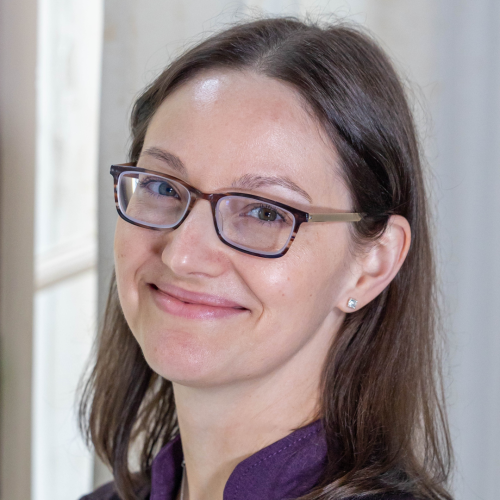
Jennifer A. Dabrowski
Associate Professor of Chemistry
Biography
Through her research, Associate Professor of Chemistry Jennifer Dabrowski seeks to understand how chemistry makes the world a better place.
As an undergraduate at Le Moyne College, Dabrowski investigated improving synthetic strategies to modifying steroids. She was awarded a National Science Foundation Research Experiences for Undergraduates fellowship to conduct computational studies on atmospheric radicals at SUNY College of Environmental Science and Forestry with Theodore Dibble, Ph.D., in 2005. She later worked as a chemistry consultant at a start-up called Source Sentinel, LLC, seeking to improve detection of VOCs in waterways.
Dabrowski’s doctoral studies in Amir Hoveyda’s lab at Boston College focused on developing catalytic, enantioselective methods for construction of tertiary and quaternary stereogenic centers through C–C bond formation. Selective access to new molecules is a critical goal in the development of new biologically active compounds for the therapeutic treatment of diseases. With an eye on how to do this more sustainably, Dabrowski conducted postdoctoral work at UNC Chapel Hill with mentor Michel Gagné on the main group catalysis of boro-silane complexes for the reduction of biomass.
Dabrowski began her independent career at Elon University, where she earned tenure and was named the A. L. Hook Emerging Scholar in Science and Mathematics for her scholarship efforts and passion for undergraduate research.
Education
- Ph.D. Chemistry, Boston College
- B.S. Chemistry, Le Moyne College
Courses Taught
- General Chemistry I
- Organic Chemistry II
Research Interests
The Dabrowski research group focuses on the following areas:
- Sustainable Access to Medicine: Developing Catalysts, Methods, and Molecules with Metals
- We strive to utilize the principles of organometallics to design catalysts that will selectively activate biorenewable resources as a means to create consumer feedstocks, building blocks for consumer-based products that are currently produced from crude oil sources.
- Investigation of the Bioinorganic Chemistry of Vanadium
- Investigating the fundamental structure-reactivity profile of vanadium complexes with peptides that have secondary structure and those containing vanadium–carbon bonds.
- With collaborators, exploring the biological activity of vanadium complexes, especially as antibiotics.
- Chemical Education
- Examining reflective and metacognitive practices in the introductory chemistry sequence.
- Designing and developing chemistry curriculum around the joys of food and cooking.
Please visit the Dabrowski group website for the latest news and updates
- “Recipe Modification as a Means of Learning and Applying the Scientific Method,” Dabrowski, J. A; Manson McManamy, M. E. J. Chem. Educ. 2021, 98, 5, 1610–1621.
- “Design of Culinary Transformations – a Chemistry Course for Nonscience Majors,” Dabrowski, J. A; Manson McManamy, M. E. J. Chem. Educ. 2020, 97, 1283–1288.
- “Homogeneous catalysis for the production of low-volume, high-value chemicals from biomass,” Bender, T. A.; Dabrowski, J. A.; Gagné, M. R. Nature Reviews Chemistry 2018, 2, 35–46.
- “Delineating The Multiple Roles of B(C6F5)3 in the Chemoselective Deoxygenation of Unsaturated Poly-ols,” Bender, T. A.; Dabrowski, J. A.; Gagné, M. R. ACS Catal. 2016, 6, 8399–8403.
- “Diastereoselective B(C6F5)3-Catalyzed Reductive Carbocyclization of Unsaturated Carbohydrates,” Bender, T. A.; Dabrowski, J. A.; Zhong, H.; Gagné, M. R. Org. Lett. 2016, 18, 4120–4123. Highlighted in Organic Chemistry Portal ‘Organic Chemistry Highlight’.
- “Chemoselective Conversion of Biologically Sourced Polyols into Chiral Synthons,” Adduci, L. L; Bender, T. A.; Dabrowski, J. A.; Gagné, M. R. Nature Chemistry, 2015, 7, 576–581. Highlighted in Nature News and Reviews, SYNFORMS, and C&E News.
- “Enantioselective Synthesis of Quaternary Carbon Stereogenic Centers through Cu-Catalyzed Conjugate Additions of Aryl – and Alkylaluminum Reagents to Acyclic Trisubstituted Enones,” Dabrowski, J. A.; Villaume, M. T.; Hoveyda, A. H. Angew. Chem., Int. Ed. 2013, 52, 8156–8159. Highlighted in SynFacts.
- “Combining NHC–Cu and Brønsted Base Catalysis: Enantioselective Allylic Substitution/Conjugate Addition with Alkynylaluminum Reagents and their Stereospecific Isomerization to Trisubstituted Allenes,” Dabrowski, J. A.; Haeffner, F.; Hoveyda, A. H. Angew. Chem., Int. Ed. 2013, 52, 7694–7699. Selected by the Editor as a Very Important Paper and highlighted in a ChemCatChem article and in SynFacts.
- “Enantioselective Synthesis of Alkyne-Substituted Quaternary Carbon Stereogenic Centers through NHC−Cu-Catalyzed Allylic Substitution Reactions with (i-Bu)2(Alkynyl)aluminum Reagents,” Dabrowski, J. A.; Gao, F.; Hoveyda, A. H. J. Am. Chem. Soc., 2011, 133, 4778–4781.
- “Formation of Vinyl-, Vinylhalide- or Acyl-Substituted Quaternary Carbon Stereogenic Centers through NHC−Cu-Catalyzed Enantioselective Conjugate Additions of Si-Containing Vinylaluminums to β-Substituted Cyclic Enones,” May, T. L.; Dabrowski, J. A.; Hoveyda, A. H. J. Am. Chem. Soc., 2011, 133, 736–739. Highlighted in SynFacts.
- “Catalytic and Regioselective Ring Expansion of Arylcyclobutanones with Trimethylsilyldiazomethane. Ligand-Dependent Entry to β-Ketosilane or Enolsilane Adducts,” Dabrowski, J. A.; Moebius, D. C.; Wommack, A. J.; Kornahrens, A. F.; Kingsbury, J. S. Org. Lett., 2010, 12, 3598–3601.